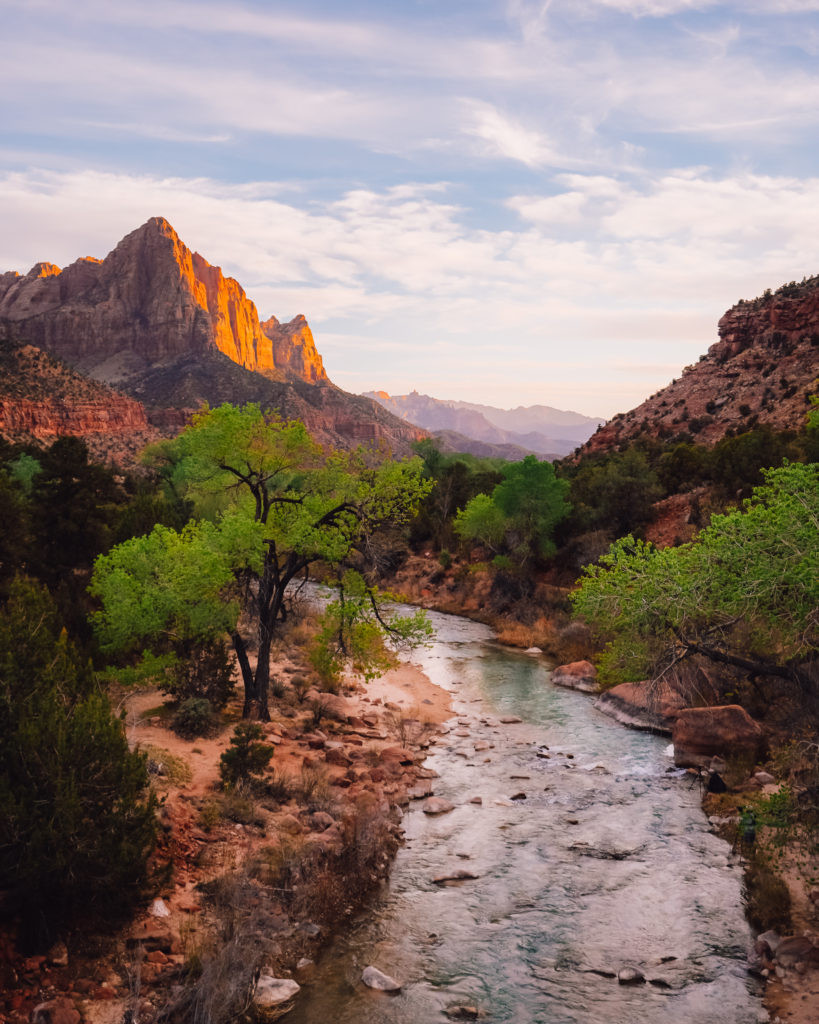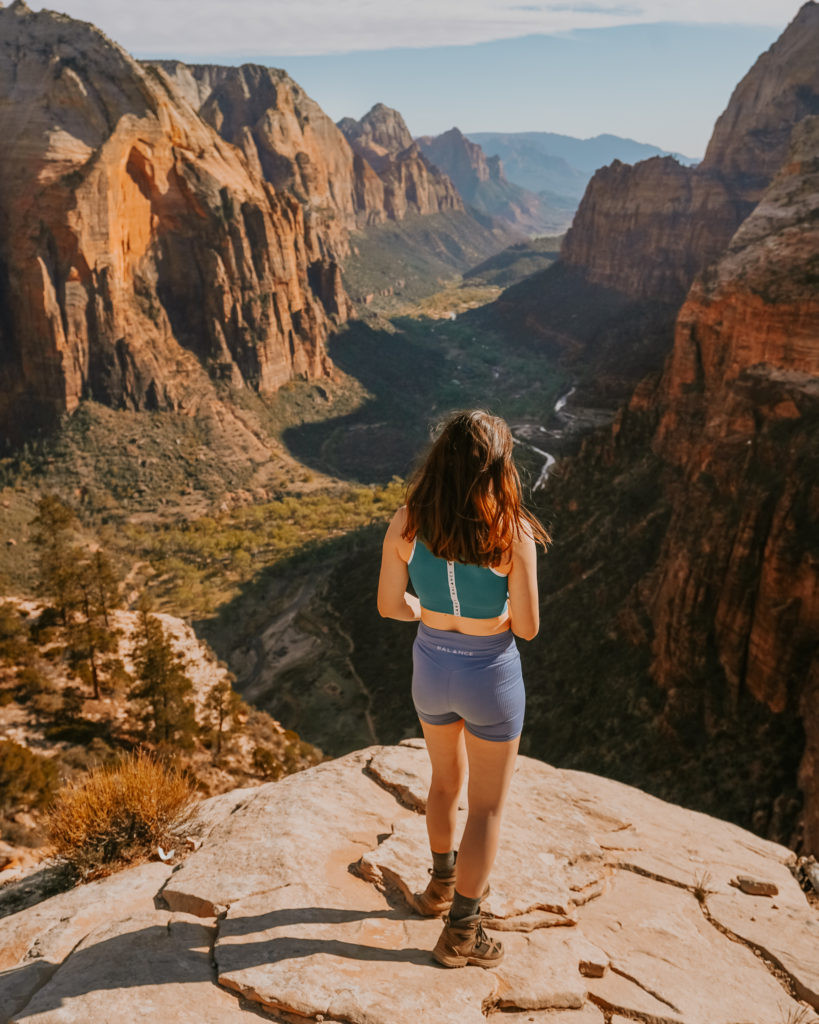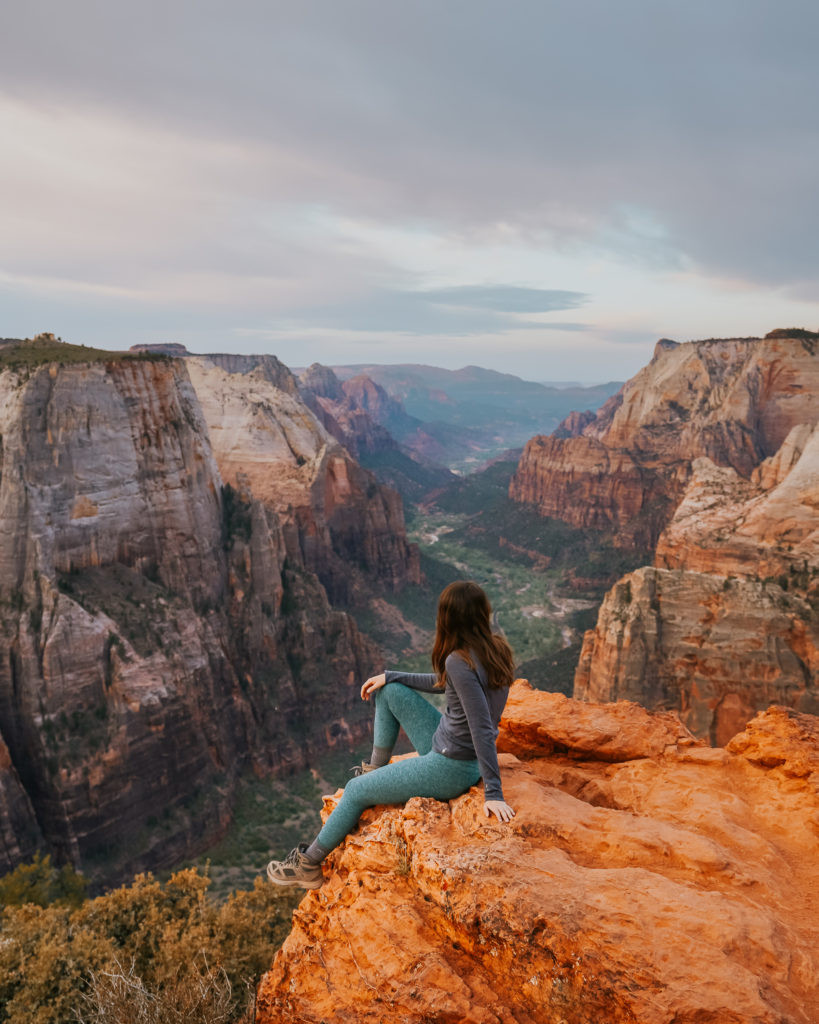Travel To Zion National Park offers breathtaking landscapes and unforgettable experiences. Let SIXT.VN guide you through planning your trip, ensuring a seamless and memorable adventure. Discover expert tips, must-see attractions, and essential travel advice for an extraordinary journey.
1. What Makes Travel to Zion National Park So Special?
Travel to Zion National Park is special because of its unique geological formations, stunning scenic views, and diverse range of activities. Zion’s towering sandstone cliffs, the Virgin River carving through the canyon, and the numerous hiking trails provide an unparalleled natural experience.
Zion National Park, located in southwestern Utah, is renowned for its extraordinary natural beauty. The park’s main feature, Zion Canyon, boasts steep red rock cliffs formed by the Virgin River over millions of years. According to the National Park Service, Zion’s geological history includes nine formations that together represent 150 million years of mostly Mesozoic-aged sedimentation. This rich history has created a landscape unlike any other, attracting millions of visitors each year.
1.1. What Are The Key Attractions Within Zion National Park?
Key attractions include Angels Landing, The Narrows, Observation Point, and Emerald Pools. Each offers unique hiking experiences and stunning views.
- Angels Landing: A challenging hike with rewarding panoramic views. Note that permits are now required to manage crowding.
- The Narrows: A unique hike through the Virgin River, often requiring wading or swimming.
- Observation Point: Offers arguably the best overall view of Zion Canyon.
- Emerald Pools: A series of trails leading to beautiful waterfalls and pools.
1.2. What Activities Can I Enjoy When I Travel To Zion National Park?
Visitors can enjoy hiking, canyoneering, rock climbing, and scenic drives. The park also offers ranger-led programs and guided tours.
- Hiking: Trails range from easy walks to strenuous climbs, catering to all skill levels.
- Canyoneering: Explore narrow canyons with rappelling and swimming (permits and experience required).
- Rock Climbing: Numerous climbing routes for experienced climbers.
- Scenic Drives: The Zion-Mount Carmel Highway offers stunning views and access to various trailheads.
1.3. Why Is The Scenery Of Zion National Park So Unique?
The unique scenery is due to the geological history, with the Virgin River cutting through layers of sandstone, creating dramatic canyons and rock formations.
Zion’s distinctive landscape is a result of millions of years of geological activity. The Virgin River continues to shape the canyon, eroding the sandstone and creating new formations. According to a study by the U.S. Geological Survey, the ongoing erosion contributes to the park’s ever-changing scenery, making each visit a unique experience.
 Zion National Park Scenic View
Zion National Park Scenic View
2. When Is The Best Time To Travel To Zion National Park?
The best times to travel to Zion National Park are in the spring and fall for pleasant weather and fewer crowds. Summer is ideal for water activities, but temperatures can be high. Winter offers solitude but can be cold.
The ideal time to visit Zion largely depends on your preferences and tolerance for weather conditions and crowds.
- Spring (March-May): Moderate temperatures and blooming wildflowers make this a scenic time to visit.
- Summer (June-August): Hot weather is perfect for hiking in The Narrows, but be prepared for crowds.
- Fall (September-November): Similar to spring, with comfortable temperatures and beautiful fall colors.
- Winter (December-February): Cold and quiet, with fewer visitors and the chance to see the park covered in snow.
2.1. What Are The Typical Weather Conditions During Each Season?
Weather conditions vary significantly by season. Spring and fall offer mild temperatures, while summer is hot and winter is cold.
| Season | Temperature Range | Typical Weather Conditions |
|---|---|---|
| Spring | 60-80°F (15-27°C) | Mild and pleasant, occasional rain. |
| Summer | 90-110°F (32-43°C) | Hot and dry, ideal for water activities. |
| Fall | 60-80°F (15-27°C) | Comfortable, with cooler evenings and colorful foliage. |
| Winter | 30-50°F (-1-10°C) | Cold, with possible snow and ice. |
2.2. How Do Crowds Vary Throughout The Year?
Crowds are highest in the summer months and during holiday weekends. Spring and fall offer a balance of good weather and fewer visitors. Winter is the least crowded time.
According to the National Park Service, Zion sees the highest number of visitors in the summer months, particularly in July and August. Visiting during the shoulder seasons (spring and fall) can provide a more enjoyable experience with fewer people.
2.3. Are There Any Seasonal Activities That Are Recommended?
- Summer: Hiking The Narrows is best during the summer when the water is warmer.
- Winter: The park offers cross-country skiing and snowshoeing when conditions allow.
2.4. How Can I Avoid The Crowds When I Travel To Zion National Park?
To avoid crowds, visit during the off-season (winter) or shoulder seasons (spring and fall). Arrive early in the morning to popular trailheads, and consider exploring lesser-known areas of the park.
3. How Do I Get To Zion National Park?
Zion National Park has two main entrances: the west entrance near Springdale, Utah, and the east entrance along the Zion-Mount Carmel Highway. The most common option is the west entrance, closest to the visitor center.
3.1. What Are The Best Routes To Reach The Park?
- From Las Vegas: Take I-15 North to Utah Highway 9 East. This route takes approximately 2.5 to 3 hours.
- From Salt Lake City: Take I-15 South to Utah Highway 9 East. This route takes approximately 4.5 to 5 hours.
3.2. Is There Public Transportation Available?
Public transportation options are limited. The park operates a free shuttle system within Zion Canyon during peak season. The town of Springdale also offers a shuttle service that connects to the park entrance.
During the peak season, private vehicles are typically not allowed on Zion Canyon Scenic Drive. The free shuttle is the primary means of accessing popular trailheads and viewpoints.
3.3. What Should I Know About The Zion-Mount Carmel Tunnel?
The Zion-Mount Carmel Tunnel has size restrictions for vehicles. Larger vehicles require a one-way traffic control, which involves a fee. Check for construction schedules as they can add 30-40 minutes to your drive.
The Zion-Mount Carmel Tunnel, completed in 1930, is a historic engineering feat. According to the National Park Service, vehicles 7′ 10″ wide or 11′ 4″ tall or larger require a tunnel escort, which can be arranged at the entrance.
3.4. Where Can I Park My Vehicle?
Parking is available at the Zion Canyon Visitor Center, but it fills up quickly during peak season. Consider parking in Springdale and using the town shuttle to access the park entrance.
4. What Are The Top Hikes In Zion National Park?
Zion National Park offers a variety of hikes, from easy strolls to challenging climbs.
4.1. Angels Landing
A strenuous 4.4-mile hike with steep switchbacks and a final section along a narrow ridge with chains. Permits are required due to its popularity.
- Distance: 4.4 miles round trip
- Difficulty: Strenuous
- Permit Required: Yes
4.2. The Narrows
A unique hike through the Virgin River, ranging from easy walks to full-day treks. Check water levels and weather conditions before attempting this hike.
- Distance: Varies (up to 16 miles)
- Difficulty: Moderate to Strenuous
- Special Gear: Water shoes, hiking stick
4.3. Observation Point
Accessible via the East Mesa Trail, this 6.7-mile hike offers stunning views of Zion Canyon. A 4×4 vehicle is recommended to reach the trailhead.
- Distance: 6.7 miles round trip
- Difficulty: Moderate
- Access: 4×4 vehicle recommended
4.4. Emerald Pools Trail
A moderate hike with multiple trails leading to different pools and waterfalls.
- Distance: Varies (1.2 to 3 miles)
- Difficulty: Easy to Moderate
4.5. Canyon Overlook Trail
An easy 1-mile hike with panoramic views of Zion Canyon. Located east of the Zion-Mount Carmel Tunnel, so it does not require using the park shuttle.
- Distance: 1 mile round trip
- Difficulty: Easy
- Shuttle Required: No
 Angels Landing Zion National Park
Angels Landing Zion National Park
5. Where Can I Stay When I Travel To Zion National Park?
Accommodation options range from campgrounds to hotels in Springdale and nearby towns.
5.1. Campgrounds Inside The Park
- South Campground: Open year-round, reservations recommended.
- Watchman Campground: Open year-round, reservations recommended.
- Lava Point Campground: Located off the Kolob Terrace Road, open seasonally, primitive camping.
Reservations can be made through Recreation.gov.
5.2. Hotels In Springdale
Springdale offers a variety of hotels, lodges, and vacation rentals, providing convenient access to the park entrance.
- Cable Mountain Lodge: Luxury accommodations near the park entrance.
- Zion Canyon Lodge: Comfortable rooms with scenic views.
- Holiday Inn Express Springdale: Reliable chain hotel with amenities.
5.3. Dispersed Camping Options
Dispersed camping is allowed in designated areas outside the park. Check with the local BLM (Bureau of Land Management) office for regulations and restrictions.
5.4. Recommendations For Booking Accommodations
Book accommodations well in advance, especially if traveling during peak season. Consider staying in Springdale for easy access to the park.
6. What Should I Pack For My Trip To Zion National Park?
Packing the right gear is essential for a comfortable and safe trip.
6.1. Essential Clothing Items
- Hiking shorts and pants
- Active shirts (moisture-wicking)
- Fleece jacket
- Lightweight jacket
- Sun hat
- Sports bras
- Active underwear
- Hiking socks
- Hiking boots
- Sandals
- Thermals (for camping)
6.2. Necessary Accessories
- Sunscreen
- Headlamp
- Hiking daypack
- Reusable water bottle
- Sunglasses
6.3. Other Important Items
- Toiletries
- Medications
- Camera
- First-aid kit
- America the Beautiful Pass (if applicable)
 Observation Point Zion National Park
Observation Point Zion National Park
6.4. Specific Items For Summer Vs. Winter
- Summer: Swimsuit, extra water, electrolyte tablets.
- Winter: Warm layers, microspikes for icy trails.
7. What Are Some Easy Zion Adventures?
For those with limited time or families with children, there are several easy and accessible activities.
7.1. Visitor Center And Par’us Trail
The Par’us Trail is a 3.4-mile paved trail that starts near the visitor center, perfect for biking and walking.
7.2. Zion Canyon Overlook Trail
A short and easy hike with rewarding views, located near the east entrance of the park.
7.3. Biking In Zion Canyon
Rent bikes and explore the scenic Zion Canyon Scenic Drive, accessible by bike when the shuttle is in operation.
7.4. Shopping And Ice Cream In Springdale
Explore the art galleries and enjoy local treats in the town of Springdale.
8. What Are Some Other Zion Adventures?
Beyond hiking, Zion offers a variety of guided tours and unique experiences.
8.1. The Narrows Guided Tour
Explore The Narrows with an experienced guide who can provide safety tips and insights into the canyon’s geology.
8.2. Zion Sunset Jeep Tour
Take a guided jeep tour to remote areas of the park for stunning sunset views.
8.3. East Zion Crimson Canyon Hike & UTV Adventure
Combine hiking and off-roading with a UTV adventure in East Zion.
8.4. Zion National Park Private Guided Hike & Picnic
Enjoy a personalized hiking experience with a private guide and a catered picnic lunch.
9. What Are The Park Regulations And Safety Tips?
Understanding and following park regulations is crucial for a safe and enjoyable visit.
9.1. Shuttle System
During peak season, the Zion Canyon Scenic Drive is only accessible via the park shuttle. Check the National Park Service website for the most up-to-date information on shuttle schedules and requirements.
9.2. Permit Requirements
Permits are required for Angels Landing and The Subway. Apply in advance through the National Park Service website.
9.3. Leave No Trace Principles
Follow Leave No Trace principles to minimize your impact on the environment:
- Plan ahead and prepare
- Travel and camp on durable surfaces
- Dispose of waste properly
- Leave what you find
- Minimize campfire impacts
- Respect wildlife
- Be considerate of other visitors
9.4. Safety Tips For Hiking
- Check the weather forecast before hiking
- Bring plenty of water and snacks
- Wear appropriate footwear
- Tell someone your hiking plans
- Be aware of your surroundings
10. Frequently Asked Questions (FAQs) About Travel To Zion National Park
10.1. Do I Need A Permit To Hike Angels Landing?
Yes, a permit is required to hike Angels Landing.
10.2. When Is The Shuttle System In Operation?
The shuttle system typically operates from March to November. Check the National Park Service website for current schedules.
10.3. What Should I Do If The Parking Lot At The Visitor Center Is Full?
Park in Springdale and use the town shuttle to access the park entrance.
10.4. Can I Swim In The Virgin River?
Yes, swimming is allowed in the Virgin River, but be aware of water levels and currents.
10.5. Are There Guided Tours Available In Zion National Park?
Yes, several companies offer guided tours for hiking, canyoneering, and other activities.
10.6. Is There Cell Service In Zion National Park?
Cell service is limited in the park. Do not rely on cell service for navigation or emergencies.
10.7. Are Pets Allowed In Zion National Park?
Pets are allowed in limited areas, including on the Pa’rus Trail. They are not allowed on other trails or in the wilderness areas.
10.8. What Is The Best Way To See The Narrows?
Hike The Narrows from the bottom up, starting at the Temple of Sinawava. Check water levels and weather conditions before hiking.
10.9. What Are The Entrance Fees For Zion National Park?
Entrance fees vary. Consider purchasing an America the Beautiful Pass for access to all national parks.
10.10. Can I Rent Gear For Hiking The Narrows?
Yes, several outfitters in Springdale rent gear for hiking The Narrows, including water shoes and hiking sticks.
SIXT.VN: Your Partner For Unforgettable Travel To Vietnam
While Zion National Park offers incredible natural beauty, SIXT.VN specializes in making your travel experiences in Vietnam seamless and memorable. From airport transfers to hotel bookings and guided tours, we provide comprehensive services tailored to your needs.
SIXT.VN Services
- Airport Transfers: Start your trip stress-free with our reliable airport transfer services.
- Hotel Bookings: Choose from a wide range of accommodations to suit your budget and preferences.
- Guided Tours: Explore Vietnam’s hidden gems with our expert-led tours.
Plan Your Vietnam Adventure Today
Ready to explore the beauty and culture of Vietnam? Contact SIXT.VN today to start planning your dream trip.
Address: 260 Cau Giay, Hanoi, Vietnam
Hotline/WhatsApp: +84 986 244 358
Website: SIXT.VN
Let SIXT.VN handle the details, so you can focus on creating lasting memories.



